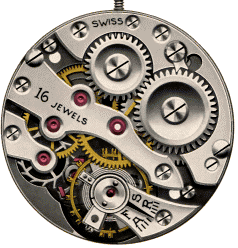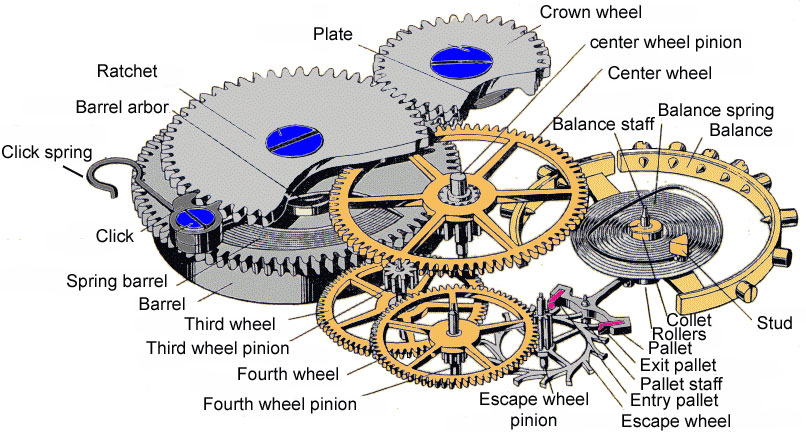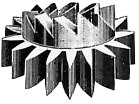

Working of a simple mechanical watch 
Sketch of a mechanical watch :


The two sides of a mechanical watch :
Geartrain side
This is the side you could see if on the back of your watch there was a glass.
On this side is the mechanism that works the watch.
This side is made up of the main plate that holds the geartrain and the
bridges.
Terminology of the geartrain

Working:
When you wind up your watch with the crown, you tighten its spring.
The winding stem ![]() is equipped with a
is equipped with a  winding pinion.
winding pinion.
and a sliding pinion (or wig-wag pinion). 
The hole of the wig-wag pinion is square and lays freely on the square part of the stem.
When you wind up your watch, the wig-wag pinion is held against the winding pinion thanks to the yoke.
The square part of the stem drives the wig-wag pinion that in turn drives the winding pinion thanks to its "Breguet" toothing.
Thanks to the crown wheel, the winding pinion drives the ratchet that is fixed on the square part of the barrel arbor.
The click prevents the ratchet from coming back and thus from unwinding again the spring barrel.
The barrel arbor  moves freely in the barrel drum
moves freely in the barrel drum  The spring barrel
The spring barrel  is fixed to the arbor thanks to the hook and the drum on the large inner diameter
is fixed to the arbor thanks to the hook and the drum on the large inner diameter  .
.
To sum up :
When you wind up your watch, you tighten to its maximum the spring around the barrel arbour.
Then, when your piece works, the spring wants to get back to its initial position. In consequence, it pulls the barrel drum that in turn transmits the driving force to the geartrain.
The driving force reaches the escapement. The escapement transmits gradually the driving force to the balance.
Thanks to this force, the balance swings and your watch works.

Winding Mechanism side
This is the side of your watch that is under the dial and the hands.
On this side are the winding mechanism and the hand-setting mechanism.
Winding terminology

Working:
See above for the reassembling
The hand-setting: When you pull the winding stem in order to regulate your watch, the setting lever, thanks to its stud that enters into the recess of the stem, is set in motion. This movement of the setting lever pushes the yoke forward.
In consequence, the sliding pinion engages with the intermediate wheel.
Then, the intermediate wheel engages with the minute wheel that in turn engages with the cannon-pinion, that holds the minute hand, and with the hour wheel, that holds the hour hand.
In the meanwhile, the winding pinion is free and cannot engage the crown wheel because the sliding pinion and the winding pinion are no longer in contact with one another.
Eric Cosandey
© 
toute reproduction strictement interdite
Tweet